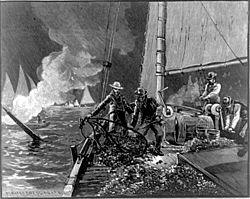Oyster Wars facts for kids
Quick facts for kids Oyster Wars |
|||
|---|---|---|---|

Oyster War engagement in 1886.
|
|||
| Date | 1865–1959 | ||
| Location | |||
| Parties to the civil conflict | |||
|
|
|||
| Casualties | |||
|
|||
The Oyster Wars were a series of fights that sometimes turned violent. These disputes happened between groups of people who illegally collected oysters (called oyster pirates) and the government authorities and legal fishermen (called watermen). The conflicts took place in the waters of the Chesapeake Bay and the Potomac River from 1865 until about 1959.
Contents
Why the Fights Started
In 1830, the state of Maryland made a rule that only people living in Maryland could collect oysters from its waters. Maryland also made it illegal to use a special tool called a dredge to collect oysters. A dredge is like a big net or rake dragged along the bottom to scoop up oysters. Virginia, another state nearby, allowed dredging until 1879.
In 1865, Maryland passed another law. This new rule said that anyone collecting oysters needed to buy a special permit each year. Many people see this new permit law as the start of the Oyster Wars.
Big Clashes Over Oysters
After the American Civil War ended, the business of collecting oysters grew very quickly. By the 1880s, almost half of all the oysters in the world came from the Chesapeake Bay!
Fishermen from New England started coming to the Bay because they had collected too many oysters in their own areas. This led to angry and sometimes violent fights with the local fishermen from Maryland and Virginia. Even fishermen from different counties within Maryland and Virginia sometimes fought each other.
How Governments Responded
Maryland's Actions
In 1868, Maryland created a special police group called the Maryland Oyster Police Force. People often called it the Oyster Navy. This group was the first version of today's Maryland Natural Resources Police.
A man named Hunter Davidson, who had graduated from the United States Naval Academy, led the Oyster Navy. Their job was to make sure people followed Maryland's oyster-collecting laws. However, this force was often not strong enough to stop the more heavily armed watermen who were breaking the rules.
Virginia's Efforts
Virginia also tried to stop illegal oyster collecting. In the 1870s, Virginia started charging fees for licenses, set limits on when oysters could be collected, and put other rules in place. These rules were meant to stop people from collecting too many oysters and to protect the oyster population.
But Virginia didn't have much money, so it was hard for them to enforce the laws. They even sold their three police boats!
Governor Cameron's Fight Against Pirates
When violence broke out between fishermen using hand-held tongs (called oyster tongers) and richer fishermen using dredges, Virginia banned oyster dredging in 1879.
Many armed groups using dredges, especially from Maryland, ignored this ban. Virginia's Governor William E. Cameron saw a chance to become more popular by fighting these "pirates." Governor Cameron even led a trip himself to catch the illegal dredgers.
On February 17, 1882, Governor Cameron's group, using a tugboat called Victoria J. Peed and a freighter called Louisa, fought the pirates near the Rappahannock River. The governor's raid was successful! They caught 41 dredgers, and seven of their boats were taken away. This event was a big success for Governor Cameron.
Later, when Governor Cameron's popularity went down and dredgers returned to the Bay, he tried a second trip. He used the Peed again, and a bigger boat called Pamlico became his main ship. But this second trip wasn't as successful. The dredgers they caught were often found not guilty in court or managed to escape.
Newspapers that didn't support the governor made fun of him. They joked that he couldn't catch the Dancing Molly, a small sailboat run by three women who managed to get away from his ships. A funny play was even made about the governor's trip in April 1883.
In 1884, Governor Cameron created a new group called the "Board on the Chesapeake and its Tributaries." This group helped improve law enforcement and manage the oyster fishing better.
The violent conflicts finally started to end in 1959. That year, a leader named H. C. Byrd ordered the fisheries police to stop carrying weapons after an officer killed a Virginia waterman who was illegally dredging. This decision is believed to have helped bring an end to the violent Oyster Wars.


